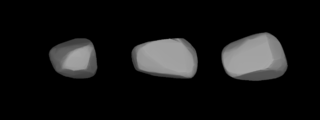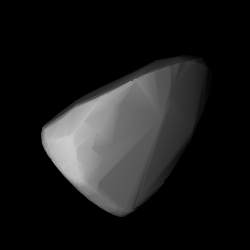Related Research Articles

1996 Adams, provisional designation 1961 UA, is a stony Eunomia asteroid from the middle region of the asteroid belt, approximately 13 kilometers in diameter. It was discovered on 16 October 1961, by the Indiana Asteroid Program at Goethe Link Observatory near Brooklyn, Indiana, United States. It was later named after mathematician John Couch Adams.

1554 Yugoslavia, provisional designation 1940 RE, is a stony Eunomian asteroid from the middle region of the asteroid belt, approximately 16 kilometres (9.9 mi) in diameter. It was discovered by Serbian astronomer Milorad Protić at Belgrade Astronomical Observatory, Serbia, on 6 September 1940. It was named for the former country of Yugoslavia.
6377 Cagney, provisional designation 1987 ML1, is a carbonaceous Eunomia asteroid from the central region of the asteroid belt, approximately 9 kilometers in diameter.
9549 Akplatonov, provisional designation 1985 SM2, is an Eunomia asteroid from the central region of the asteroid belt, approximately 8.2 kilometers (5.1 miles) in diameter. It was discovered on 19 September 1985, by Soviet–Russian astronomer couple Nikolai and Lyudmila Chernykh at the Crimean Astrophysical Observatory in Nauchnyj, on the Crimean peninsula. The likely S-type asteroid has a relatively short rotation period of 2.8 hours. It was named for Russian computational mathematician Aleksandr Platonov.
6296 Cleveland, provisional designation 1988 NC, is a Hungaria asteroid from the innermost regions of the asteroid belt, approximately 3.5 kilometers in diameter. It was discovered on 12 July 1988, by American astronomer Eleanor Helin at the Palomar Observatory in California. The presumed E-type asteroid has a long rotation period of 30.8 hours and possibly an elongated shape. It was named for the city of Cleveland in the U.S. state of Ohio.
3915 Fukushima, provisional designation 1988 PA1, is a carbonaceous asteroid from the inner regions of the asteroid belt, approximately 21 kilometers in diameter.
2005 Hencke, provisional designation 1973 RA, is a stony Eunomia asteroid from the middle region of the asteroid belt, approximately 10 kilometers in diameter. It was discovered by Swiss astronomer Paul Wild at Zimmerwald Observatory near Bern, Switzerland, on 2 September 1973. The asteroid was named after German amateur astronomer Karl Ludwig Hencke.
11118 Modra is a Flora asteroid of uncertain composition from the inner regions of the asteroid belt, approximately 5 kilometers in diameter.
5542 Moffatt, provisional designation 1978 PT4, is a Marian asteroid from the central regions of the asteroid belt, approximately 9 kilometers (6 miles) in diameter. It was discovered on 6 August 1978, by astronomers at the Perth Observatory in Bickley, Australia. The likely S-type asteroid has a rotation period of 5.19 hours. It was named for Australian Ethelwin Moffatt, a benefactor of the discovering observatory.
1318 Nerina, provisional designation 1934 FG, is a Phocaea asteroid from the inner regions of the asteroid belt, approximately 13 kilometers in diameter. It was discovered on 24 March 1934, by South African astronomer Cyril Jackson at the Union Observatory in Johannesburg. The possibly metallic X-type asteroid has a notably short rotation period of 2.5 hours. It was named for the flowering plant Nerine, also known as "Guernsey lily" or "Jersey lily".
2308 Schilt, provisional designation 1967 JM, is a stony Eunomia asteroid from the asteroid belt, approximately 17 kilometers in diameter. It was discovered on 6 May 1967, by Argentine astronomer Carlos Cesco together with American astronomer Arnold Klemola at the Yale–Columbia Southern Station at Leoncito Astronomical Complex in Argentina.
3133 Sendai, provisional designation A907 TC, is a stony Flora asteroid from the inner regions of the asteroid belt, approximately 8 kilometers in diameter. It was discovered on 4 October 1907, by German astronomer August Kopff at Heidelberg Observatory in southwest Germany. The asteroid was named for the Japanese city of Sendai.
5692 Shirao, provisional designation 1992 FR, is a stony Eunomia asteroid from the middle region of the asteroid belt, approximately 9 kilometers in diameter. It was discovered on 23 March 1992, by Japanese amateur astronomers Kin Endate and Kazuro Watanabe at Kitami Observatory, Hokkaidō, Japan. The asteroid was later named for Japanese geologist and astrophotographer Motomaro Shirao.
2035 Stearns, provisional designation 1973 SC, is a bright Hungaria asteroid and sizable Mars-crosser inside the inner regions of the asteroid belt, approximately 6 kilometers in diameter. It was discovered on 21 September 1973, by American astronomer James Gibson at the Leoncito Astronomical Complex in Argentina. The transitional E-type asteroid has a long rotation period of 93 hours. It was named after American astronomer Carl Leo Stearns.
1506 Xosa, provisional designation 1939 JC, is a stony asteroid and slow rotator from the middle region of the asteroid belt, approximately 13 kilometers in diameter. It was discovered on 15 May 1939, by English-born, South African astronomer Cyril Jackson at the Johannesburg Observatory in South Africa. It is named for the Xhosa people.
5855 Yukitsuna, provisional designation 1992 UO2, is a stony Marian asteroid from the central regions of the asteroid belt, approximately 11 kilometers (7 miles) in diameter. It was discovered on 26 October 1992, by Japanese astronomers Akira Natori and Takeshi Urata at the JCPM Yakiimo Station. The likely elongated S-type asteroid has a rotation period of 19 hours. It was named for Minamoto no Yukitsuna, a Japanese general during the Heian era.
1775 Zimmerwald, provisional designation 1969 JA, is a stony Eunomian asteroid and slow rotator from the middle region of the asteroid belt, approximately 10 kilometers in diameter. It was discovered on 13 May 1969, by Swiss astronomer Paul Wild at Zimmerwald Observatory near Bern, Switzerland. It is named for the village of Zimmerwald, where the discovering observatory is located.
10645 Brač, provisional designation 1999 ES4, is a stony Eunomia asteroid from the central region of the asteroid belt, approximately 10 kilometers in diameter. It was discovered on 14 March 1999, by Croatian astronomer Korado Korlević at Višnjan Observatory, and named after the Croatian island of Brač.
52266 Van Flandern is a stony Phocaea asteroid from the inner regions of the asteroid belt, approximately 4 kilometers in diameter. It was discovered on 10 January 1986, by American astronomers Carolyn and Eugene Shoemaker at the Palomar Observatory in California, United States. The asteroid was later named for American astronomer Tom Van Flandern.
8026 Johnmckay, provisional designation 1991 JA1, is a binary Hungaria asteroid and very slow rotator from the inner regions of the asteroid belt, approximately 2 kilometers in diameter. It was discovered on 8 May 1991, by American astronomer Eleanor Helin at the U.S. Palomar Observatory, California, and later named for NASA test pilot John B. McKay.
References
- 1 2 3 4 5 6 "4175 Billbaum (1985 GX)". Minor Planet Center. Retrieved 25 April 2018.
- 1 2 3 4 "JPL Small-Body Database Browser: 4175 Billbaum (1985 GX)" (2017-09-28 last obs.). Jet Propulsion Laboratory . Retrieved 25 April 2018.
- 1 2 "Asteroid 4175 Billbaum – Proper Elements". AstDyS-2, Asteroids – Dynamic Site. Retrieved 29 October 2019.
- 1 2 3 4 5 6 7 8 9 10 "LCDB Data for (4175) Billbaum". Asteroid Lightcurve Database (LCDB). Retrieved 25 April 2018.
- 1 2 3 4 Masiero, Joseph R.; Mainzer, A. K.; Grav, T.; Bauer, J. M.; Cutri, R. M.; Nugent, C.; et al. (November 2012). "Preliminary Analysis of WISE/NEOWISE 3-Band Cryogenic and Post-cryogenic Observations of Main Belt Asteroids". The Astrophysical Journal Letters. 759 (1): 5. arXiv: 1209.5794 . Bibcode:2012ApJ...759L...8M. doi:10.1088/2041-8205/759/1/L8.
- 1 2 Ditteon, Richard; West, Josh (October 2011). "Asteroid Lightcurve Analysis at the Oakley Southern Observatory: 2011 January thru April". The Minor Planet Bulletin. 38 (4): 214–217. Bibcode:2011MPBu...38..214D. ISSN 1052-8091.
- 1 2 Aymami, Josep Maria (July 2011). "CCD Photometry and Lightcurve Analysis of 1318 Nerina, 4175 Billbaum and 5168 Jenner from Observatori Carmelita (MPC B20) in Tiana". The Minor Planet Bulletin. 38 (3): 158–159. Bibcode:2011MPBu...38..158A. ISSN 1052-8091.
- 1 2 3 Veres, Peter; Jedicke, Robert; Fitzsimmons, Alan; Denneau, Larry; Granvik, Mikael; Bolin, Bryce; et al. (November 2015). "Absolute magnitudes and slope parameters for 250,000 asteroids observed by Pan-STARRS PS1 - Preliminary results". Icarus. 261: 34–47. arXiv: 1506.00762 . Bibcode:2015Icar..261...34V. doi:10.1016/j.icarus.2015.08.007.
- ↑ "MPC/MPO/MPS Archive". Minor Planet Center. Retrieved 25 April 2018.